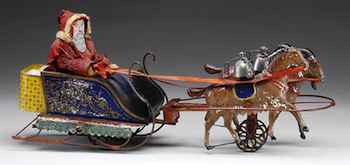- MENU
- HOME
- SEARCH
- WORLD
- MAIN
- AFRICA
- ASIA
- BALKANS
- EUROPE
- LATIN AMERICA
- MIDDLE EAST
- United Kingdom
- United States
- Argentina
- Australia
- Austria
- Benelux
- Brazil
- Canada
- China
- France
- Germany
- Greece
- Hungary
- India
- Indonesia
- Ireland
- Israel
- Italy
- Japan
- Korea
- Mexico
- New Zealand
- Pakistan
- Philippines
- Poland
- Russia
- South Africa
- Spain
- Taiwan
- Turkey
- USA
- BUSINESS
- WEALTH
- STOCKS
- TECH
- HEALTH
- LIFESTYLE
- ENTERTAINMENT
- SPORTS
- RSS
- iHaveNet.com
Danielle Arnet

Christmas in July! Considered one of the rarest American-made tin toys, the Santa sleigh pulled by goats brought $161,000 recently in a James D. Julia auction
Let's talk money. Doesn't everyone? By our unscientific reckoning, roughly 85 percent of reader mail these days is about selling. Most involve collections or individual items left by a family member.
Another 10 percent or so ask about value of something they have, but don't mention selling. The rest is a mixed lot, mainly "What is this?" Others request a source or contact.
Truth is, I cannot remember when this column last got an inquiry about buying. It's the times. Collecting has been hit by a double whammy of factors.
First, it's the economy. Most readers are so involved in trying to keep ahead of job losses, energy costs, health care and so forth that buying for pleasure is a last priority.
But reality runs deeper than that. In recessionary times, self-indulgence is out of style. It is that factor, more than anything, that influences many collectors.
It's socially correct to be green today. It's cool to be thrifty. It is smart to make do with what we have and avoid debt. But it is not fashionable to scratch the urge to collect.
The "I am what I collect" ethos is so yesterday. Will it return? Given the cyclical nature of all things, I'd bet on it.
All is not doom. While many have been affected, the market is not dead. Auction houses still collect inventory thanks to the Four D's: Debt, Death, Divorce and Disease (illness). And those who had deep pockets before the financial dip never stopped buying.
Today's reality is a discriminating, selective buyer who seeks things that are the best of their kind, and insists on top condition. The good news is that the best always sells.
Q: What is current value for my early Chessie prints?
--Lea
A: Companies learned long ago that consumers pay attention when ads feature an animal. Today, we have the
Inviting travelers to "Sleep like a Kitten," Chessie was first seen in an illustration used as an ad in
The railroad, no fools, built an ad campaign around the winsome tiger striped kitten. In time, Chessie appeared on calendars and kids clothing, in books for tots, and more ads. Chessie later gained a mate (Peake), and two kittens joined the campaign.
Streamlined in the 1970s, the original Chessie image with stylistic changes now appears on cars of the CSX rail system.
Scratch a cat person, and you'll find a collector. And, boy, is Chessie collected. Some collectors want only original and old representations. Purists stand firm on the belief that the only Chessie items that matter are those released as promos or used on the railroad, such as prints to kiddie PJs, and railroad china.
Checking completed print sales on
Smart collectors are cautious when buying paper items from the site. Remember,
On www.liveauctioneers.com, a free database of results from auction houses that use the service, we found that framed Chessies sold for
The best prices were for framed, wall-ready originals.
AUCTION ACTION: A toy Santa sleigh pulled by goats, one of only three examples known to exist, sold for
COLLECTOR QUIZ
Question: Can you match types of early American toys with their manufacturer?
1. J. and E. Stevens
2.
3.
4. Althof Bergmann
a. Clockwork and hoop toys.
b. Toy steam engines and locomotives
c. Tin and cast iron
d. "Dexter" tin horses
A: Traits overlap, but best matches are 1-c, 2-b, 3-d, 4-a. Source: "The Story of American Toys" by